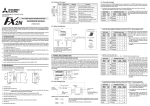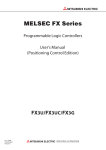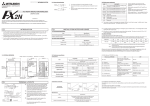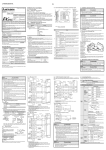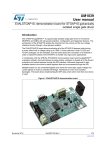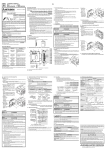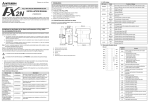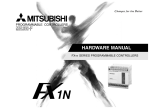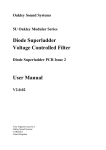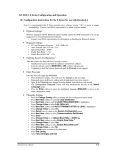Download fx2n-232if rs232c interface block hardware manual
Transcript
2.2 Connector Pin Layout Pin No. FX2N-232IF RS232C INTERFACE BLOCK HARDWARE MANUAL 5 4 3 2 1 9 8 7 6 JY992D73501B This manual contains text, diagrams and explanations which will guide the reader in the correct installation and operation of the FX 2N-232IF RS232C Interface Block. It should be read and understood before attempting to install or use the unit. Further information can be found in the FX PROGRAMMING MANUAL, FX series hardware manuals. Signal name Meaning Function 1 CD(DCD) Carrier detection This signal indicates only status. 2 RD(RXD) Receive data Receive data (RS232C device to 232IF) 3 SD(TXD) Send data Send data (232IF to RS232C device) 4 ER(DTR) Data terminal ready ON when Send/Receive enable is ON 5 SG Signal ground Signal ground 6 DR(DSR) Data set ready This signal indicates only status. 7 RS(RTS) Request to send <Clear to receive>* ON when Send command is ON <ON when 232IF is Receive enabled>* 8 CS(CTS) Clear to send ON when RS232C device is ready to receive 9 If in doubt at any stage during the installation of the FX2N-232IF RS232C Interface Block always consult a professional electrical engineer who is qualified and trained to the local and national standards. 3.3 Connection Example CI(RI) Calling indication This signal indicates only status. The signal wiring of the RS232C equipment varies depending on the RS232C specifications connected. Check the specifications of the RS232C equipment used, then connect the signals correctly. Representative wiring examples are shown below. 1) Connection with counterpart equipment of terminal specifications (when control line is not used) BFM #0 communication format: b9 = 0, b8 = 0, without control line 232IF side Signal name RS232C device side Pin No. SD(TXD) Signal name 9-pin D-SUB 25-pin D-SUB 3 2 3 SD(TXD) RD(RXD) 2 RD(RXD) 2 3 SG(GND) 5 SG(GND) 5 7 Communication is performed in accordance with the condition determined by the software in the 232IF and the counterpart equipment. < > At selection of interlink connection mode * 2.3 System Configuration 1. INTRODUCTION PLC The RS232C interface block FX2N-232IF (hereinafter referred to as "232IF") is connected to the FX2N/ FX2NC/FX3U/FX3UC series PLC to realize full duplex serial data communication with another RS232C interface such as a personal computer, bar code reader, printer, etc. FX2N/FX3U PLC Personal computer 1) Two or more devices with RS232C interfaces can be connected to an FX2N/FX2NC/FX3U/FX3UC series PLC by using the RS232C special function block. Up to 8 special function block can be connected to the FX2N/FX3U/FX3UC*1 series PLC. Up to 4 special function block can be connected to the FX2NC PLC. (Refer to section 2.1) 2) Communication requires no protocol Full-duplex asynchronous communication between RS232C devices is specified through buffer memory (BFM). The FROM/TO instruction is used for the buffer memory. RS-232C device RS-232C:max 15m FX2NC-CNV-IF or FX3UC-1PS-5V FX2NC/FX3UC PLC Bar code reader Printer 3) The send/receive buffer can accommodate 512 bytes/256 words. When the RS232C interlink connection mode is used, data exceeding 512 bytes/256 words can also can be received. 4) ASCII/HEX conversion function The function to convert and send and a hexadecimal numeric (0 to F) saved in the send data buffer as well as the function to convert a received ASCII code into a hexadecimal numeric (0 to F) and save it to the receive buffer are provided. 232IF side Signal name FX2N-232IF or 2) Connection with counterpart equipment of terminal specifications (when control line is used) Cross cable used, BFM #0 communication format: b9 = 0, b8 = 1, standard RS232C mode To connect this block to the FX2NC Series PLC, the FX2NC-CNV-IF is required To connect this block to the FX3UC Series PLC, either the FX2NC-CNV-IF or FX3UC-1PS-5V is required. RS232C device side Pin No. Signal name 9-pin D-SUB 25-pin D-SUB SD(TXD) 3 SD(TXD) 3 2 RD(RXD) 2 RD(RXD) 2 3 RS(RTS) 7 RS(RTS) 7 4 CS(CTS) 8 CS(CTS) 8 5 CD(DCD) 1 8 ER(DTR) 4 20 CD(DCD) 1 ER(DTR) 4 DR(DSR) 6 SG(GND) 5 *1 *2 DR(DSR) 6 6 SG(GND) 5 7 Because the carrier to send (CS) signal pin of the 232IF itself receives the request to send (RS) signal, signal transfer is performed as if the counterpart equipment is functioning. *1 When the CD signal is not monitored, the CD signal pin is not required to be connected. The 232IF only monitors the signal status (ON/OFF). *2 The 232IF only monitors the signal status (ON/OFF). *1 Up to 7 special function block can be connected to the FX3UC-32MT-LT PLC 3) Interlink serial cross cable used, BFM #0 communication format: b9 = 1, b8 = 1, RS232C interlink connection mode 3. WIRING AND CONNECTION 3.1 Connection with the programmable controller 2. Specifications 2.1 External Dimensions and Part Names Dimensions:mm(inches) 55(2.17") Weight: Approx. 0.3 kg ➂ ➃➄ Accessory:Special block No. label ➅ 85(3.35") 24+ ➁ RD POWER SD 90(3.54") SD 80(3.15") POWER mounting hole pitch 24- ➀ RD ➆ FX2N-232IF The 232IF can be connected to the FX2N/FX2NC/FX3U/FX3UC programmable controller or connected on the right side of another extension block/unit. A number is assigned to each special unit/block counting from the one nearest the main unit in the way of No.0, No.1. . . No.7". Up to 8 FX2N-232IF units can be connected to the FX2N/FX3U/FX3UC *1 Series PLC. Up to 4 FX2N-232IF units can be connected to the FX2NC Series PLC. However, the capacity of the 5V DC power supplied from the programmable controller is limited. The current consumption of the 5V DC power in the 232IF is 40 mA. Make sure that the total current consumption of the 5V DC power supply including other special blocks is equivalent to or less than that available. *1 Up to 7 units can be connected to an FX3UC-32MT-LT PLC L X4 X5 X6 X7 X10 IN IN 0 1 2 3 4 5 6 7 X14 X16 X20 X22 X24 X13 X15 X17 X21 X23 X25 POWER POWER 0 1 2 3 4 5 6 7 20 21 22 23 24 25 26 27 10 11 12 13 14 15 16 17 POWER SD POWER SD RD RD T.V PROG.E 6 7 20 21 22 23 24 25 26 27 MELSEC FX2N-48MR Y0 COM1 4(0.16") COM X0 X2 24+ X1 N ➇ ➉ ➈ c Extension cable 232IF side Y2 Y3 Y4 Y6 COM2 Y5 Y7 16 17 Y10 COM3 Y13 Y14 COM4 Y15 CPU.E Y20 Y22 Y24 Y26 COM5 Y21 Y23 Y25 Y27 IN 0 1 2 3 4 5 6 7 FX 2N-48MR-ES/UL FX2N-232IF X000-X027 Block No.0 Y000-Y027 FX2N -232IF Block No.1 f SD LED:Lit while data is sent to the RS232C equipment connected to the 232IF. g RD LED:Lit while data is received from the RS232C equipment connected to the 232IF. h Terminal screws (M3 (0.12")) j RS232C connector (9-pin D-SUB connector: #4-40unc inch screw thread) k DIN rail clip l DIN rail groove (35(1.38")) 6.2mm (0.24") 3 SD(TXD) 3 2 RD(RXD) 2 RD(RXD) 2 3 RS(RTS) 7 *1 RS(RTS) 7 4 CS(CTS) 8 CS(CTS) 8 5 ER(DTR) 4 ER(DTR) 4 20 DR(DSR) 6 SG(GND) 5 *2 232IF side Extension cable 24V 24+ 24FX2N -232IF 24V DC±10% 80mA DC service supply of programmable controller may be used. Handling of the crimp-style terminal 6.2mm (0.24") 25-pin D-SUB DR(DSR) 6 6 SG(GND) 5 7 *1 In this mode, the Request to Send signal (RS) functions as the receive enable signal in the 232IF. When receiving data that exceeds 512 bytes (the upper limit of the 232IF receive buffer), the 232IF sets the Request to Send signal (RS) to “OFF” and requests the counterpart equipment to suspend the data transmission. Once the data saved in the receive buffer is read by the sequence program, the remaining data can be received. 4) Connection with counterpart equipment of modem specifications (Control line is essential.) Straight cable used, BFM #0 communication format: b9 = 0, b8 = 1, standard RS232C mode FX 2N programmable controller i Next step extension connector 9-pin D-SUB X030-X047 DC service supply 0V SD(TXD) Signal name In the interlink connection mode, data exceeding 512 bytes (upper limit of the receive buffer in the 232IF) can be received. *2 The 232IF only monitors the signal status (ON/OFF). 3.2 Power Supply Wiring Class D grounding 100 Ω or less Pin No. FX2N-16EX-ES/UL d Mounting hole (2-φ4.5(0.18")) e POWER LED :Lit when both the 5V DC power supplied from the main unit and the 24V DC power supplied from the external terminal are supplied. Signal name RS232C device side Use the crimp-style terminals of the dimensions shown on the figure on the left. Make sure that the tightening torque of the terminal is 0.5 to 0.8 Nym. Tighten each terminal securely to avoid malfunction. Signal name RS232C device side Pin No. Signal name 9-pin D-SUB 25-pin D-SUB SD(TXD) 3 SD(TXD) 3 2 RD(RXD) 2 RD(RXD) 2 3 RS(RTS) 7 RS(RTS) 7 4 CS(CTS) 8 CS(CTS) 8 5 CD(DCD) 1 CD(DCD) 1 8 ER(DTR) 4 ER(DTR) 4 20 DR(DSR) 6 SG(GND) 5 CI(RI) 9 *1 *2 *3 DR(DSR) 6 6 SG(GND) 5 7 CI(RI) 9 22 *1 When the CD signal is not being monitored, the CD signal pin is not required to be connected. The 232IF only monitors the signal status (ON/OFF). *2 The 232IF only monitors the signal status (ON/OFF). *3 When the CI signal is not required, the CI signal pin is not required to be connected. The 232IF only monitors the signal status (ON/OFF). 2.2 Connector Pin Layout Pin No. FX2N-232IF RS232C INTERFACE BLOCK HARDWARE MANUAL 5 4 3 2 1 9 8 7 6 JY992D73501B This manual contains text, diagrams and explanations which will guide the reader in the correct installation and operation of the FX 2N-232IF RS232C Interface Block. It should be read and understood before attempting to install or use the unit. Further information can be found in the FX PROGRAMMING MANUAL, FX series hardware manuals. Signal name Meaning Function 1 CD(DCD) Carrier detection This signal indicates only status. 2 RD(RXD) Receive data Receive data (RS232C device to 232IF) 3 SD(TXD) Send data Send data (232IF to RS232C device) 4 ER(DTR) Data terminal ready ON when Send/Receive enable is ON 5 SG Signal ground Signal ground 6 DR(DSR) Data set ready This signal indicates only status. 7 RS(RTS) Request to send <Clear to receive>* ON when Send command is ON <ON when 232IF is Receive enabled>* 8 CS(CTS) Clear to send ON when RS232C device is ready to receive 9 If in doubt at any stage during the installation of the FX2N-232IF RS232C Interface Block always consult a professional electrical engineer who is qualified and trained to the local and national standards. 3.3 Connection Example CI(RI) Calling indication This signal indicates only status. The signal wiring of the RS232C equipment varies depending on the RS232C specifications connected. Check the specifications of the RS232C equipment used, then connect the signals correctly. Representative wiring examples are shown below. 1) Connection with counterpart equipment of terminal specifications (when control line is not used) BFM #0 communication format: b9 = 0, b8 = 0, without control line 232IF side Signal name RS232C device side Pin No. SD(TXD) Signal name 9-pin D-SUB 25-pin D-SUB 3 2 3 SD(TXD) RD(RXD) 2 RD(RXD) 2 3 SG(GND) 5 SG(GND) 5 7 Communication is performed in accordance with the condition determined by the software in the 232IF and the counterpart equipment. < > At selection of interlink connection mode * 2.3 System Configuration 1. INTRODUCTION PLC The RS232C interface block FX2N-232IF (hereinafter referred to as "232IF") is connected to the FX2N/ FX2NC/FX3U/FX3UC series PLC to realize full duplex serial data communication with another RS232C interface such as a personal computer, bar code reader, printer, etc. FX2N/FX3U PLC Personal computer 1) Two or more devices with RS232C interfaces can be connected to an FX2N/FX2NC/FX3U/FX3UC series PLC by using the RS232C special function block. Up to 8 special function block can be connected to the FX2N/FX3U/FX3UC*1 series PLC. Up to 4 special function block can be connected to the FX2NC PLC. (Refer to section 2.1) 2) Communication requires no protocol Full-duplex asynchronous communication between RS232C devices is specified through buffer memory (BFM). The FROM/TO instruction is used for the buffer memory. RS-232C device RS-232C:max 15m FX2NC-CNV-IF or FX3UC-1PS-5V FX2NC/FX3UC PLC Bar code reader Printer 3) The send/receive buffer can accommodate 512 bytes/256 words. When the RS232C interlink connection mode is used, data exceeding 512 bytes/256 words can also can be received. 4) ASCII/HEX conversion function The function to convert and send and a hexadecimal numeric (0 to F) saved in the send data buffer as well as the function to convert a received ASCII code into a hexadecimal numeric (0 to F) and save it to the receive buffer are provided. 232IF side Signal name FX2N-232IF or 2) Connection with counterpart equipment of terminal specifications (when control line is used) Cross cable used, BFM #0 communication format: b9 = 0, b8 = 1, standard RS232C mode To connect this block to the FX2NC Series PLC, the FX2NC-CNV-IF is required To connect this block to the FX3UC Series PLC, either the FX2NC-CNV-IF or FX3UC-1PS-5V is required. RS232C device side Pin No. Signal name 9-pin D-SUB 25-pin D-SUB SD(TXD) 3 SD(TXD) 3 2 RD(RXD) 2 RD(RXD) 2 3 RS(RTS) 7 RS(RTS) 7 4 CS(CTS) 8 CS(CTS) 8 5 CD(DCD) 1 8 ER(DTR) 4 20 CD(DCD) 1 ER(DTR) 4 DR(DSR) 6 SG(GND) 5 *1 *2 DR(DSR) 6 6 SG(GND) 5 7 Because the carrier to send (CS) signal pin of the 232IF itself receives the request to send (RS) signal, signal transfer is performed as if the counterpart equipment is functioning. *1 When the CD signal is not monitored, the CD signal pin is not required to be connected. The 232IF only monitors the signal status (ON/OFF). *2 The 232IF only monitors the signal status (ON/OFF). *1 Up to 7 special function block can be connected to the FX3UC-32MT-LT PLC 3) Interlink serial cross cable used, BFM #0 communication format: b9 = 1, b8 = 1, RS232C interlink connection mode 3. WIRING AND CONNECTION 3.1 Connection with the programmable controller 2. Specifications 2.1 External Dimensions and Part Names Dimensions:mm(inches) 55(2.17") Weight: Approx. 0.3 kg ➂ ➃➄ Accessory:Special block No. label ➅ 85(3.35") 24+ ➁ RD POWER SD 90(3.54") SD 80(3.15") POWER mounting hole pitch 24- ➀ RD ➆ FX2N-232IF The 232IF can be connected to the FX2N/FX2NC/FX3U/FX3UC programmable controller or connected on the right side of another extension block/unit. A number is assigned to each special unit/block counting from the one nearest the main unit in the way of No.0, No.1. . . No.7". Up to 8 FX2N-232IF units can be connected to the FX2N/FX3U/FX3UC *1 Series PLC. Up to 4 FX2N-232IF units can be connected to the FX2NC Series PLC. However, the capacity of the 5V DC power supplied from the programmable controller is limited. The current consumption of the 5V DC power in the 232IF is 40 mA. Make sure that the total current consumption of the 5V DC power supply including other special blocks is equivalent to or less than that available. *1 Up to 7 units can be connected to an FX3UC-32MT-LT PLC L X4 X5 X6 X7 X10 IN IN 0 1 2 3 4 5 6 7 X14 X16 X20 X22 X24 X13 X15 X17 X21 X23 X25 POWER POWER 0 1 2 3 4 5 6 7 20 21 22 23 24 25 26 27 10 11 12 13 14 15 16 17 POWER SD POWER SD RD RD T.V PROG.E 6 7 20 21 22 23 24 25 26 27 MELSEC FX2N-48MR Y0 COM1 4(0.16") COM X0 X2 24+ X1 N ➇ ➉ ➈ c Extension cable 232IF side Y2 Y3 Y4 Y6 COM2 Y5 Y7 16 17 Y10 COM3 Y13 Y14 COM4 Y15 CPU.E Y20 Y22 Y24 Y26 COM5 Y21 Y23 Y25 Y27 IN 0 1 2 3 4 5 6 7 FX 2N-48MR-ES/UL FX2N-232IF X000-X027 Block No.0 Y000-Y027 FX2N -232IF Block No.1 f SD LED:Lit while data is sent to the RS232C equipment connected to the 232IF. g RD LED:Lit while data is received from the RS232C equipment connected to the 232IF. h Terminal screws (M3 (0.12")) j RS232C connector (9-pin D-SUB connector: #4-40unc inch screw thread) k DIN rail clip l DIN rail groove (35(1.38")) 6.2mm (0.24") 3 SD(TXD) 3 2 RD(RXD) 2 RD(RXD) 2 3 RS(RTS) 7 *1 RS(RTS) 7 4 CS(CTS) 8 CS(CTS) 8 5 ER(DTR) 4 ER(DTR) 4 20 DR(DSR) 6 SG(GND) 5 *2 232IF side Extension cable 24V 24+ 24FX2N -232IF 24V DC±10% 80mA DC service supply of programmable controller may be used. Handling of the crimp-style terminal 6.2mm (0.24") 25-pin D-SUB DR(DSR) 6 6 SG(GND) 5 7 *1 In this mode, the Request to Send signal (RS) functions as the receive enable signal in the 232IF. When receiving data that exceeds 512 bytes (the upper limit of the 232IF receive buffer), the 232IF sets the Request to Send signal (RS) to “OFF” and requests the counterpart equipment to suspend the data transmission. Once the data saved in the receive buffer is read by the sequence program, the remaining data can be received. 4) Connection with counterpart equipment of modem specifications (Control line is essential.) Straight cable used, BFM #0 communication format: b9 = 0, b8 = 1, standard RS232C mode FX 2N programmable controller i Next step extension connector 9-pin D-SUB X030-X047 DC service supply 0V SD(TXD) Signal name In the interlink connection mode, data exceeding 512 bytes (upper limit of the receive buffer in the 232IF) can be received. *2 The 232IF only monitors the signal status (ON/OFF). 3.2 Power Supply Wiring Class D grounding 100 Ω or less Pin No. FX2N-16EX-ES/UL d Mounting hole (2-φ4.5(0.18")) e POWER LED :Lit when both the 5V DC power supplied from the main unit and the 24V DC power supplied from the external terminal are supplied. Signal name RS232C device side Use the crimp-style terminals of the dimensions shown on the figure on the left. Make sure that the tightening torque of the terminal is 0.5 to 0.8 Nym. Tighten each terminal securely to avoid malfunction. Signal name RS232C device side Pin No. Signal name 9-pin D-SUB 25-pin D-SUB SD(TXD) 3 SD(TXD) 3 2 RD(RXD) 2 RD(RXD) 2 3 RS(RTS) 7 RS(RTS) 7 4 CS(CTS) 8 CS(CTS) 8 5 CD(DCD) 1 CD(DCD) 1 8 ER(DTR) 4 ER(DTR) 4 20 DR(DSR) 6 SG(GND) 5 CI(RI) 9 *1 *2 *3 DR(DSR) 6 6 SG(GND) 5 7 CI(RI) 9 22 *1 When the CD signal is not being monitored, the CD signal pin is not required to be connected. The 232IF only monitors the signal status (ON/OFF). *2 The 232IF only monitors the signal status (ON/OFF). *3 When the CI signal is not required, the CI signal pin is not required to be connected. The 232IF only monitors the signal status (ON/OFF). 2.2 Connector Pin Layout Pin No. FX2N-232IF RS232C INTERFACE BLOCK HARDWARE MANUAL 5 4 3 2 1 9 8 7 6 JY992D73501B This manual contains text, diagrams and explanations which will guide the reader in the correct installation and operation of the FX 2N-232IF RS232C Interface Block. It should be read and understood before attempting to install or use the unit. Further information can be found in the FX PROGRAMMING MANUAL, FX series hardware manuals. Signal name Meaning Function 1 CD(DCD) Carrier detection This signal indicates only status. 2 RD(RXD) Receive data Receive data (RS232C device to 232IF) 3 SD(TXD) Send data Send data (232IF to RS232C device) 4 ER(DTR) Data terminal ready ON when Send/Receive enable is ON 5 SG Signal ground Signal ground 6 DR(DSR) Data set ready This signal indicates only status. 7 RS(RTS) Request to send <Clear to receive>* ON when Send command is ON <ON when 232IF is Receive enabled>* 8 CS(CTS) Clear to send ON when RS232C device is ready to receive 9 If in doubt at any stage during the installation of the FX2N-232IF RS232C Interface Block always consult a professional electrical engineer who is qualified and trained to the local and national standards. 3.3 Connection Example CI(RI) Calling indication This signal indicates only status. The signal wiring of the RS232C equipment varies depending on the RS232C specifications connected. Check the specifications of the RS232C equipment used, then connect the signals correctly. Representative wiring examples are shown below. 1) Connection with counterpart equipment of terminal specifications (when control line is not used) BFM #0 communication format: b9 = 0, b8 = 0, without control line 232IF side Signal name RS232C device side Pin No. SD(TXD) Signal name 9-pin D-SUB 25-pin D-SUB 3 2 3 SD(TXD) RD(RXD) 2 RD(RXD) 2 3 SG(GND) 5 SG(GND) 5 7 Communication is performed in accordance with the condition determined by the software in the 232IF and the counterpart equipment. < > At selection of interlink connection mode * 2.3 System Configuration 1. INTRODUCTION PLC The RS232C interface block FX2N-232IF (hereinafter referred to as "232IF") is connected to the FX2N/ FX2NC/FX3U/FX3UC series PLC to realize full duplex serial data communication with another RS232C interface such as a personal computer, bar code reader, printer, etc. FX2N/FX3U PLC Personal computer 1) Two or more devices with RS232C interfaces can be connected to an FX2N/FX2NC/FX3U/FX3UC series PLC by using the RS232C special function block. Up to 8 special function block can be connected to the FX2N/FX3U/FX3UC*1 series PLC. Up to 4 special function block can be connected to the FX2NC PLC. (Refer to section 2.1) 2) Communication requires no protocol Full-duplex asynchronous communication between RS232C devices is specified through buffer memory (BFM). The FROM/TO instruction is used for the buffer memory. RS-232C device RS-232C:max 15m FX2NC-CNV-IF or FX3UC-1PS-5V FX2NC/FX3UC PLC Bar code reader Printer 3) The send/receive buffer can accommodate 512 bytes/256 words. When the RS232C interlink connection mode is used, data exceeding 512 bytes/256 words can also can be received. 4) ASCII/HEX conversion function The function to convert and send and a hexadecimal numeric (0 to F) saved in the send data buffer as well as the function to convert a received ASCII code into a hexadecimal numeric (0 to F) and save it to the receive buffer are provided. 232IF side Signal name FX2N-232IF or 2) Connection with counterpart equipment of terminal specifications (when control line is used) Cross cable used, BFM #0 communication format: b9 = 0, b8 = 1, standard RS232C mode To connect this block to the FX2NC Series PLC, the FX2NC-CNV-IF is required To connect this block to the FX3UC Series PLC, either the FX2NC-CNV-IF or FX3UC-1PS-5V is required. RS232C device side Pin No. Signal name 9-pin D-SUB 25-pin D-SUB SD(TXD) 3 SD(TXD) 3 2 RD(RXD) 2 RD(RXD) 2 3 RS(RTS) 7 RS(RTS) 7 4 CS(CTS) 8 CS(CTS) 8 5 CD(DCD) 1 8 ER(DTR) 4 20 CD(DCD) 1 ER(DTR) 4 DR(DSR) 6 SG(GND) 5 *1 *2 DR(DSR) 6 6 SG(GND) 5 7 Because the carrier to send (CS) signal pin of the 232IF itself receives the request to send (RS) signal, signal transfer is performed as if the counterpart equipment is functioning. *1 When the CD signal is not monitored, the CD signal pin is not required to be connected. The 232IF only monitors the signal status (ON/OFF). *2 The 232IF only monitors the signal status (ON/OFF). *1 Up to 7 special function block can be connected to the FX3UC-32MT-LT PLC 3) Interlink serial cross cable used, BFM #0 communication format: b9 = 1, b8 = 1, RS232C interlink connection mode 3. WIRING AND CONNECTION 3.1 Connection with the programmable controller 2. Specifications 2.1 External Dimensions and Part Names Dimensions:mm(inches) 55(2.17") Weight: Approx. 0.3 kg ➂ ➃➄ Accessory:Special block No. label ➅ 85(3.35") 24+ ➁ RD POWER SD 90(3.54") SD 80(3.15") POWER mounting hole pitch 24- ➀ RD ➆ FX2N-232IF The 232IF can be connected to the FX2N/FX2NC/FX3U/FX3UC programmable controller or connected on the right side of another extension block/unit. A number is assigned to each special unit/block counting from the one nearest the main unit in the way of No.0, No.1. . . No.7". Up to 8 FX2N-232IF units can be connected to the FX2N/FX3U/FX3UC *1 Series PLC. Up to 4 FX2N-232IF units can be connected to the FX2NC Series PLC. However, the capacity of the 5V DC power supplied from the programmable controller is limited. The current consumption of the 5V DC power in the 232IF is 40 mA. Make sure that the total current consumption of the 5V DC power supply including other special blocks is equivalent to or less than that available. *1 Up to 7 units can be connected to an FX3UC-32MT-LT PLC L X4 X5 X6 X7 X10 IN IN 0 1 2 3 4 5 6 7 X14 X16 X20 X22 X24 X13 X15 X17 X21 X23 X25 POWER POWER 0 1 2 3 4 5 6 7 20 21 22 23 24 25 26 27 10 11 12 13 14 15 16 17 POWER SD POWER SD RD RD T.V PROG.E 6 7 20 21 22 23 24 25 26 27 MELSEC FX2N-48MR Y0 COM1 4(0.16") COM X0 X2 24+ X1 N ➇ ➉ ➈ c Extension cable 232IF side Y2 Y3 Y4 Y6 COM2 Y5 Y7 16 17 Y10 COM3 Y13 Y14 COM4 Y15 CPU.E Y20 Y22 Y24 Y26 COM5 Y21 Y23 Y25 Y27 IN 0 1 2 3 4 5 6 7 FX 2N-48MR-ES/UL FX2N-232IF X000-X027 Block No.0 Y000-Y027 FX2N -232IF Block No.1 f SD LED:Lit while data is sent to the RS232C equipment connected to the 232IF. g RD LED:Lit while data is received from the RS232C equipment connected to the 232IF. h Terminal screws (M3 (0.12")) j RS232C connector (9-pin D-SUB connector: #4-40unc inch screw thread) k DIN rail clip l DIN rail groove (35(1.38")) 6.2mm (0.24") 3 SD(TXD) 3 2 RD(RXD) 2 RD(RXD) 2 3 RS(RTS) 7 *1 RS(RTS) 7 4 CS(CTS) 8 CS(CTS) 8 5 ER(DTR) 4 ER(DTR) 4 20 DR(DSR) 6 SG(GND) 5 *2 232IF side Extension cable 24V 24+ 24FX2N -232IF 24V DC±10% 80mA DC service supply of programmable controller may be used. Handling of the crimp-style terminal 6.2mm (0.24") 25-pin D-SUB DR(DSR) 6 6 SG(GND) 5 7 *1 In this mode, the Request to Send signal (RS) functions as the receive enable signal in the 232IF. When receiving data that exceeds 512 bytes (the upper limit of the 232IF receive buffer), the 232IF sets the Request to Send signal (RS) to “OFF” and requests the counterpart equipment to suspend the data transmission. Once the data saved in the receive buffer is read by the sequence program, the remaining data can be received. 4) Connection with counterpart equipment of modem specifications (Control line is essential.) Straight cable used, BFM #0 communication format: b9 = 0, b8 = 1, standard RS232C mode FX 2N programmable controller i Next step extension connector 9-pin D-SUB X030-X047 DC service supply 0V SD(TXD) Signal name In the interlink connection mode, data exceeding 512 bytes (upper limit of the receive buffer in the 232IF) can be received. *2 The 232IF only monitors the signal status (ON/OFF). 3.2 Power Supply Wiring Class D grounding 100 Ω or less Pin No. FX2N-16EX-ES/UL d Mounting hole (2-φ4.5(0.18")) e POWER LED :Lit when both the 5V DC power supplied from the main unit and the 24V DC power supplied from the external terminal are supplied. Signal name RS232C device side Use the crimp-style terminals of the dimensions shown on the figure on the left. Make sure that the tightening torque of the terminal is 0.5 to 0.8 Nym. Tighten each terminal securely to avoid malfunction. Signal name RS232C device side Pin No. Signal name 9-pin D-SUB 25-pin D-SUB SD(TXD) 3 SD(TXD) 3 2 RD(RXD) 2 RD(RXD) 2 3 RS(RTS) 7 RS(RTS) 7 4 CS(CTS) 8 CS(CTS) 8 5 CD(DCD) 1 CD(DCD) 1 8 ER(DTR) 4 ER(DTR) 4 20 DR(DSR) 6 SG(GND) 5 CI(RI) 9 *1 *2 *3 DR(DSR) 6 6 SG(GND) 5 7 CI(RI) 9 22 *1 When the CD signal is not being monitored, the CD signal pin is not required to be connected. The 232IF only monitors the signal status (ON/OFF). *2 The 232IF only monitors the signal status (ON/OFF). *3 When the CI signal is not required, the CI signal pin is not required to be connected. The 232IF only monitors the signal status (ON/OFF). 4. SPECIFICATIONS 4.1 General specifications General specifications excluding withstand voltage Same as those of the main unit Withstand voltage 500V AC, 1 minute (between the entire external terminal and the ground terminal) 4.2 Power Supply Specifications Internal power supply from programmable controller 5V DC 40mA External power supply 24V DC ± 10% 80mA 4.3 Specifications Item Content Transmission Standard Conforming RS232C Transmission distance Max. 15m Connected the number 1:1 Connector 9-pin D-SUB type Pin layout of connector 1:CD(DCD), 2:RD(RXD), 3:SD(TXD), 4:ER(DTR), 5:SG, 6:DR(DSR), 7:RS(RTS), 8:CS(CTS), 9:CI(RI) Indication (LED) POWER, SD, RD Communication method No protocol by full-duplex asynchronous Sported baud rate 300, 600, 1200, 2400, 4800, 9600, 19200 Isolation Photo-coupler Number of I/O points occupied 8 points taken from the programmable controller extension bus (can be either input or output) Applicable programmable controllers FX2N/FX2NC/FX3U/FX3UC series Communication with programmable controller FROM/TO instruction Guidelines for the safety of the user and protection of the FX2N-232IF RS232C INTERFACE BLOCK 5. DIAGNOSTICS For error code, refer to the FX Communication User’s Manual. • This manual has been written to be used by trained and competent personnel. This is defined by the European directives for machinery, low voltage and EMC. • If in doubt at any stage during the installation of the FX2N-232IF always consult a professional electrical engineer who is qualified and trained to the local and national standards. If in doubt about the operation or use of the FX2N-232IF please consult the nearest Mitsubishi Electric distributor. • Under no circumstances will Mitsubishi Electric be liable or responsible for any consequential damage that may arise as a result of the installation or use of this equipment. • All examples and diagrams shown in this manual are intended only as an aid to understanding the text, not to guarantee operation. Mitsubishi Electric will accept no responsibility for actual use of the product based on these illustrative examples. • Owing to the very great variety in possible application of this equipment, you must satisfy yourself as to its suitability for your specific application. 1) Check the status of the POWER LED provided in the 232IF. - When it is lit, the drive power is correctly supplied. - If it is extinguished, supply the drive power correctly. 2) Check the status of the SD LED and the RD LED provided in the 232IF. - If the RD LED is not lit while data is received or the SD LED is not lighted while data is sent, check the instruction and the wiring. - When the RD LED is lit while data is received or the SD LED is lit while data is sent, the installation and the wiring are correct. 3) Make sure that the communication setting (BFM #0) of the 232IF is equivalent to that of the external equipment. If they are not equivalent each other, correct as required. 4) Verify the status of the data send/receive device. For example, make sure that the counterpart equipment is ready to receive before starting to send data to it. 5) When the terminator is not used, check whether the send data capacity is equivalent to the acceptable data capacity. Use the terminator, if the send data capacity may be changed. 6) Make sure that the external equipment is correctly operating. This manual confers no industrial property rights or any rights of any other kind, nor does it confer any patent licenses. Mitsubishi Electric Corporation cannot be held responsible for any problems involving industrial property rights which may occur as a result of using the contents noted in this manual. 7) Check whether the type of send data and the type of receive data are equivalent. If they are different, make them equivalent. Manual number : JY992D73501 Manual revision : B Date : SEP 2007 HEAD OFFICE : TOKYO BUILDING, 2-7-3 MARUNOUCHI, CHIYODA-KU, TOKYO 100-8310, JAPAN HIMEJI WORKS : 840, CHIYODA CHO, HIMEJI, JAPAN JY992D73501B Effective SEP. 2007 Specifications are subject to change without notice 4. SPECIFICATIONS 4.1 General specifications General specifications excluding withstand voltage Same as those of the main unit Withstand voltage 500V AC, 1 minute (between the entire external terminal and the ground terminal) 4.2 Power Supply Specifications Internal power supply from programmable controller 5V DC 40mA External power supply 24V DC ± 10% 80mA 4.3 Specifications Item Content Transmission Standard Conforming RS232C Transmission distance Max. 15m Connected the number 1:1 Connector 9-pin D-SUB type Pin layout of connector 1:CD(DCD), 2:RD(RXD), 3:SD(TXD), 4:ER(DTR), 5:SG, 6:DR(DSR), 7:RS(RTS), 8:CS(CTS), 9:CI(RI) Indication (LED) POWER, SD, RD Communication method No protocol by full-duplex asynchronous Sported baud rate 300, 600, 1200, 2400, 4800, 9600, 19200 Isolation Photo-coupler Number of I/O points occupied 8 points taken from the programmable controller extension bus (can be either input or output) Applicable programmable controllers FX2N/FX2NC/FX3U/FX3UC series Communication with programmable controller FROM/TO instruction Guidelines for the safety of the user and protection of the FX2N-232IF RS232C INTERFACE BLOCK 5. DIAGNOSTICS For error code, refer to the FX Communication User’s Manual. • This manual has been written to be used by trained and competent personnel. This is defined by the European directives for machinery, low voltage and EMC. • If in doubt at any stage during the installation of the FX2N-232IF always consult a professional electrical engineer who is qualified and trained to the local and national standards. If in doubt about the operation or use of the FX2N-232IF please consult the nearest Mitsubishi Electric distributor. • Under no circumstances will Mitsubishi Electric be liable or responsible for any consequential damage that may arise as a result of the installation or use of this equipment. • All examples and diagrams shown in this manual are intended only as an aid to understanding the text, not to guarantee operation. Mitsubishi Electric will accept no responsibility for actual use of the product based on these illustrative examples. • Owing to the very great variety in possible application of this equipment, you must satisfy yourself as to its suitability for your specific application. 1) Check the status of the POWER LED provided in the 232IF. - When it is lit, the drive power is correctly supplied. - If it is extinguished, supply the drive power correctly. 2) Check the status of the SD LED and the RD LED provided in the 232IF. - If the RD LED is not lit while data is received or the SD LED is not lighted while data is sent, check the instruction and the wiring. - When the RD LED is lit while data is received or the SD LED is lit while data is sent, the installation and the wiring are correct. 3) Make sure that the communication setting (BFM #0) of the 232IF is equivalent to that of the external equipment. If they are not equivalent each other, correct as required. 4) Verify the status of the data send/receive device. For example, make sure that the counterpart equipment is ready to receive before starting to send data to it. 5) When the terminator is not used, check whether the send data capacity is equivalent to the acceptable data capacity. Use the terminator, if the send data capacity may be changed. 6) Make sure that the external equipment is correctly operating. This manual confers no industrial property rights or any rights of any other kind, nor does it confer any patent licenses. Mitsubishi Electric Corporation cannot be held responsible for any problems involving industrial property rights which may occur as a result of using the contents noted in this manual. 7) Check whether the type of send data and the type of receive data are equivalent. If they are different, make them equivalent. Manual number : JY992D73501 Manual revision : B Date : SEP 2007 HEAD OFFICE : TOKYO BUILDING, 2-7-3 MARUNOUCHI, CHIYODA-KU, TOKYO 100-8310, JAPAN HIMEJI WORKS : 840, CHIYODA CHO, HIMEJI, JAPAN JY992D73501B Effective SEP. 2007 Specifications are subject to change without notice 2.2 Connector Pin Layout Pin No. FX2N-232IF RS232C INTERFACE BLOCK HARDWARE MANUAL 5 4 3 2 1 9 8 7 6 JY992D73501B This manual contains text, diagrams and explanations which will guide the reader in the correct installation and operation of the FX 2N-232IF RS232C Interface Block. It should be read and understood before attempting to install or use the unit. Further information can be found in the FX PROGRAMMING MANUAL, FX series hardware manuals. Signal name Meaning Function 1 CD(DCD) Carrier detection This signal indicates only status. 2 RD(RXD) Receive data Receive data (RS232C device to 232IF) 3 SD(TXD) Send data Send data (232IF to RS232C device) 4 ER(DTR) Data terminal ready ON when Send/Receive enable is ON 5 SG Signal ground Signal ground 6 DR(DSR) Data set ready This signal indicates only status. 7 RS(RTS) Request to send <Clear to receive>* ON when Send command is ON <ON when 232IF is Receive enabled>* 8 CS(CTS) Clear to send ON when RS232C device is ready to receive 9 If in doubt at any stage during the installation of the FX2N-232IF RS232C Interface Block always consult a professional electrical engineer who is qualified and trained to the local and national standards. 3.3 Connection Example CI(RI) Calling indication This signal indicates only status. The signal wiring of the RS232C equipment varies depending on the RS232C specifications connected. Check the specifications of the RS232C equipment used, then connect the signals correctly. Representative wiring examples are shown below. 1) Connection with counterpart equipment of terminal specifications (when control line is not used) BFM #0 communication format: b9 = 0, b8 = 0, without control line 232IF side Signal name RS232C device side Pin No. SD(TXD) Signal name 9-pin D-SUB 25-pin D-SUB 3 2 3 SD(TXD) RD(RXD) 2 RD(RXD) 2 3 SG(GND) 5 SG(GND) 5 7 Communication is performed in accordance with the condition determined by the software in the 232IF and the counterpart equipment. < > At selection of interlink connection mode * 2.3 System Configuration 1. INTRODUCTION PLC The RS232C interface block FX2N-232IF (hereinafter referred to as "232IF") is connected to the FX2N/ FX2NC/FX3U/FX3UC series PLC to realize full duplex serial data communication with another RS232C interface such as a personal computer, bar code reader, printer, etc. FX2N/FX3U PLC Personal computer 1) Two or more devices with RS232C interfaces can be connected to an FX2N/FX2NC/FX3U/FX3UC series PLC by using the RS232C special function block. Up to 8 special function block can be connected to the FX2N/FX3U/FX3UC*1 series PLC. Up to 4 special function block can be connected to the FX2NC PLC. (Refer to section 2.1) 2) Communication requires no protocol Full-duplex asynchronous communication between RS232C devices is specified through buffer memory (BFM). The FROM/TO instruction is used for the buffer memory. RS-232C device RS-232C:max 15m FX2NC-CNV-IF or FX3UC-1PS-5V FX2NC/FX3UC PLC Bar code reader Printer 3) The send/receive buffer can accommodate 512 bytes/256 words. When the RS232C interlink connection mode is used, data exceeding 512 bytes/256 words can also can be received. 4) ASCII/HEX conversion function The function to convert and send and a hexadecimal numeric (0 to F) saved in the send data buffer as well as the function to convert a received ASCII code into a hexadecimal numeric (0 to F) and save it to the receive buffer are provided. 232IF side Signal name FX2N-232IF or 2) Connection with counterpart equipment of terminal specifications (when control line is used) Cross cable used, BFM #0 communication format: b9 = 0, b8 = 1, standard RS232C mode To connect this block to the FX2NC Series PLC, the FX2NC-CNV-IF is required To connect this block to the FX3UC Series PLC, either the FX2NC-CNV-IF or FX3UC-1PS-5V is required. RS232C device side Pin No. Signal name 9-pin D-SUB 25-pin D-SUB SD(TXD) 3 SD(TXD) 3 2 RD(RXD) 2 RD(RXD) 2 3 RS(RTS) 7 RS(RTS) 7 4 CS(CTS) 8 CS(CTS) 8 5 CD(DCD) 1 8 ER(DTR) 4 20 CD(DCD) 1 ER(DTR) 4 DR(DSR) 6 SG(GND) 5 *1 *2 DR(DSR) 6 6 SG(GND) 5 7 Because the carrier to send (CS) signal pin of the 232IF itself receives the request to send (RS) signal, signal transfer is performed as if the counterpart equipment is functioning. *1 When the CD signal is not monitored, the CD signal pin is not required to be connected. The 232IF only monitors the signal status (ON/OFF). *2 The 232IF only monitors the signal status (ON/OFF). *1 Up to 7 special function block can be connected to the FX3UC-32MT-LT PLC 3) Interlink serial cross cable used, BFM #0 communication format: b9 = 1, b8 = 1, RS232C interlink connection mode 3. WIRING AND CONNECTION 3.1 Connection with the programmable controller 2. Specifications 2.1 External Dimensions and Part Names Dimensions:mm(inches) 55(2.17") Weight: Approx. 0.3 kg ➂ ➃➄ Accessory:Special block No. label ➅ 85(3.35") 24+ ➁ RD POWER SD 90(3.54") SD 80(3.15") POWER mounting hole pitch 24- ➀ RD ➆ FX2N-232IF The 232IF can be connected to the FX2N/FX2NC/FX3U/FX3UC programmable controller or connected on the right side of another extension block/unit. A number is assigned to each special unit/block counting from the one nearest the main unit in the way of No.0, No.1. . . No.7". Up to 8 FX2N-232IF units can be connected to the FX2N/FX3U/FX3UC *1 Series PLC. Up to 4 FX2N-232IF units can be connected to the FX2NC Series PLC. However, the capacity of the 5V DC power supplied from the programmable controller is limited. The current consumption of the 5V DC power in the 232IF is 40 mA. Make sure that the total current consumption of the 5V DC power supply including other special blocks is equivalent to or less than that available. *1 Up to 7 units can be connected to an FX3UC-32MT-LT PLC L X4 X5 X6 X7 X10 IN IN 0 1 2 3 4 5 6 7 X14 X16 X20 X22 X24 X13 X15 X17 X21 X23 X25 POWER POWER 0 1 2 3 4 5 6 7 20 21 22 23 24 25 26 27 10 11 12 13 14 15 16 17 POWER SD POWER SD RD RD T.V PROG.E 6 7 20 21 22 23 24 25 26 27 MELSEC FX2N-48MR Y0 COM1 4(0.16") COM X0 X2 24+ X1 N ➇ ➉ ➈ c Extension cable 232IF side Y2 Y3 Y4 Y6 COM2 Y5 Y7 16 17 Y10 COM3 Y13 Y14 COM4 Y15 CPU.E Y20 Y22 Y24 Y26 COM5 Y21 Y23 Y25 Y27 IN 0 1 2 3 4 5 6 7 FX 2N-48MR-ES/UL FX2N-232IF X000-X027 Block No.0 Y000-Y027 FX2N -232IF Block No.1 f SD LED:Lit while data is sent to the RS232C equipment connected to the 232IF. g RD LED:Lit while data is received from the RS232C equipment connected to the 232IF. h Terminal screws (M3 (0.12")) j RS232C connector (9-pin D-SUB connector: #4-40unc inch screw thread) k DIN rail clip l DIN rail groove (35(1.38")) 6.2mm (0.24") 3 SD(TXD) 3 2 RD(RXD) 2 RD(RXD) 2 3 RS(RTS) 7 *1 RS(RTS) 7 4 CS(CTS) 8 CS(CTS) 8 5 ER(DTR) 4 ER(DTR) 4 20 DR(DSR) 6 SG(GND) 5 *2 232IF side Extension cable 24V 24+ 24FX2N -232IF 24V DC±10% 80mA DC service supply of programmable controller may be used. Handling of the crimp-style terminal 6.2mm (0.24") 25-pin D-SUB DR(DSR) 6 6 SG(GND) 5 7 *1 In this mode, the Request to Send signal (RS) functions as the receive enable signal in the 232IF. When receiving data that exceeds 512 bytes (the upper limit of the 232IF receive buffer), the 232IF sets the Request to Send signal (RS) to “OFF” and requests the counterpart equipment to suspend the data transmission. Once the data saved in the receive buffer is read by the sequence program, the remaining data can be received. 4) Connection with counterpart equipment of modem specifications (Control line is essential.) Straight cable used, BFM #0 communication format: b9 = 0, b8 = 1, standard RS232C mode FX 2N programmable controller i Next step extension connector 9-pin D-SUB X030-X047 DC service supply 0V SD(TXD) Signal name In the interlink connection mode, data exceeding 512 bytes (upper limit of the receive buffer in the 232IF) can be received. *2 The 232IF only monitors the signal status (ON/OFF). 3.2 Power Supply Wiring Class D grounding 100 Ω or less Pin No. FX2N-16EX-ES/UL d Mounting hole (2-φ4.5(0.18")) e POWER LED :Lit when both the 5V DC power supplied from the main unit and the 24V DC power supplied from the external terminal are supplied. Signal name RS232C device side Use the crimp-style terminals of the dimensions shown on the figure on the left. Make sure that the tightening torque of the terminal is 0.5 to 0.8 Nym. Tighten each terminal securely to avoid malfunction. Signal name RS232C device side Pin No. Signal name 9-pin D-SUB 25-pin D-SUB SD(TXD) 3 SD(TXD) 3 2 RD(RXD) 2 RD(RXD) 2 3 RS(RTS) 7 RS(RTS) 7 4 CS(CTS) 8 CS(CTS) 8 5 CD(DCD) 1 CD(DCD) 1 8 ER(DTR) 4 ER(DTR) 4 20 DR(DSR) 6 SG(GND) 5 CI(RI) 9 *1 *2 *3 DR(DSR) 6 6 SG(GND) 5 7 CI(RI) 9 22 *1 When the CD signal is not being monitored, the CD signal pin is not required to be connected. The 232IF only monitors the signal status (ON/OFF). *2 The 232IF only monitors the signal status (ON/OFF). *3 When the CI signal is not required, the CI signal pin is not required to be connected. The 232IF only monitors the signal status (ON/OFF). 4. SPECIFICATIONS 4.1 General specifications General specifications excluding withstand voltage Same as those of the main unit Withstand voltage 500V AC, 1 minute (between the entire external terminal and the ground terminal) 4.2 Power Supply Specifications Internal power supply from programmable controller 5V DC 40mA External power supply 24V DC ± 10% 80mA 4.3 Specifications Item Content Transmission Standard Conforming RS232C Transmission distance Max. 15m Connected the number 1:1 Connector 9-pin D-SUB type Pin layout of connector 1:CD(DCD), 2:RD(RXD), 3:SD(TXD), 4:ER(DTR), 5:SG, 6:DR(DSR), 7:RS(RTS), 8:CS(CTS), 9:CI(RI) Indication (LED) POWER, SD, RD Communication method No protocol by full-duplex asynchronous Sported baud rate 300, 600, 1200, 2400, 4800, 9600, 19200 Isolation Photo-coupler Number of I/O points occupied 8 points taken from the programmable controller extension bus (can be either input or output) Applicable programmable controllers FX2N/FX2NC/FX3U/FX3UC series Communication with programmable controller FROM/TO instruction Guidelines for the safety of the user and protection of the FX2N-232IF RS232C INTERFACE BLOCK 5. DIAGNOSTICS For error code, refer to the FX Communication User’s Manual. • This manual has been written to be used by trained and competent personnel. This is defined by the European directives for machinery, low voltage and EMC. • If in doubt at any stage during the installation of the FX2N-232IF always consult a professional electrical engineer who is qualified and trained to the local and national standards. If in doubt about the operation or use of the FX2N-232IF please consult the nearest Mitsubishi Electric distributor. • Under no circumstances will Mitsubishi Electric be liable or responsible for any consequential damage that may arise as a result of the installation or use of this equipment. • All examples and diagrams shown in this manual are intended only as an aid to understanding the text, not to guarantee operation. Mitsubishi Electric will accept no responsibility for actual use of the product based on these illustrative examples. • Owing to the very great variety in possible application of this equipment, you must satisfy yourself as to its suitability for your specific application. 1) Check the status of the POWER LED provided in the 232IF. - When it is lit, the drive power is correctly supplied. - If it is extinguished, supply the drive power correctly. 2) Check the status of the SD LED and the RD LED provided in the 232IF. - If the RD LED is not lit while data is received or the SD LED is not lighted while data is sent, check the instruction and the wiring. - When the RD LED is lit while data is received or the SD LED is lit while data is sent, the installation and the wiring are correct. 3) Make sure that the communication setting (BFM #0) of the 232IF is equivalent to that of the external equipment. If they are not equivalent each other, correct as required. 4) Verify the status of the data send/receive device. For example, make sure that the counterpart equipment is ready to receive before starting to send data to it. 5) When the terminator is not used, check whether the send data capacity is equivalent to the acceptable data capacity. Use the terminator, if the send data capacity may be changed. 6) Make sure that the external equipment is correctly operating. This manual confers no industrial property rights or any rights of any other kind, nor does it confer any patent licenses. Mitsubishi Electric Corporation cannot be held responsible for any problems involving industrial property rights which may occur as a result of using the contents noted in this manual. 7) Check whether the type of send data and the type of receive data are equivalent. If they are different, make them equivalent. Manual number : JY992D73501 Manual revision : B Date : SEP 2007 HEAD OFFICE : TOKYO BUILDING, 2-7-3 MARUNOUCHI, CHIYODA-KU, TOKYO 100-8310, JAPAN HIMEJI WORKS : 840, CHIYODA CHO, HIMEJI, JAPAN JY992D73501B Effective SEP. 2007 Specifications are subject to change without notice








